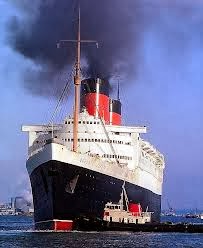 |
| The QE 1 - just a good excuse to remember this grand ship |
The problem with QE is that one can regulate the amount and types of asset that are purchased but one has absolutely no idea where the resulting “hot money” will end up being invested – sadly for the US, the UK and Japan (the main proponents of QE) most of this hot money has eschewed low returns in domestic economies in favour of the more tigerish returns in emerging markets. On the face of it this it doesn’t sound too bad but the problem for emerging markets is one of history; as they say in the east end of London they’ve “got previous”.
In the 1990s the bank of Japan cut interest rates close to zero and experimented with QE. Between 1991 and 1995 the yen lost almost half of its value. Japanese investors dumped Japan and invested into the tiger economies - Korea, Malaysia, Philippines, Thailand, etc. The Japanese were followed by others who borrowed in Japan (at low rates) and invested in the same economies. The stock markets of South Korea, Malaysia, Singapore, Thailand, and Indonesia boomed until…..! When the Thai currency came under pressure in June 1997, these same economies found out just how fickle investment managers can be. These erstwhile tigers faced massive out-flows of capital, stock markets crashed, and currencies were devalued – some even had bank defaults.
In 2008, many of the developing economies tried to avoid the concerns of the “Great Recession”, which was raging in the West, by adopting expansionist fiscal and monetary policies, similar to Japan. Part of the economic cocktail was massive doses of quantitative easing (QE) by the Fed and to a lesser degree by the Bank of England. Western banks were given lots of new money to play with and looking for higher returns than were available at home, the money flooded out into the far flung corners of the world in search of yield.
John Mauldin explains the effect of this QE on emerging markets as - For them (emerging markets) it is like having loads of visitors drop by all of a sudden. It is flattering that they like your house; but after a while, you'd rather they didn't show up unexpectedly. Hot money flows are like drunken guests. They create a very big party, they leave unexpectedly, and they leave a god-awful mess behind.
This great increase in the availability of credit created bubbles and sucked in imports - widening of current account deficits in some emerging markets. When the money started to flow the other way last summer India, Indonesia, Brazil, Turkey and South Africa were worst effected and to this list we can now add Argentina, Russia, and Chile – let’s call them the “endangered eight”.
Although yields are still poor in the West “tapering” the rate of QE has now created a rush of liquid funds away for Emerging markets and back into the developed world (the London property market has be a beneficiary). The consequence of these outflows is that Investors have lost confidence in emerging markets - currencies and asset prices are tumbling. The big question now is whether we on the edge of an emerging market abyss?
Central bankers in emerging markets have been forced respond by raising interest rates to deal with falling currencies (Since the first taper warning on May 21, 2013 Argentina, Indonesia, Turkey, Brazil, and South Africa have seen their currencies fall more than 15%). They must hope that lower currency values will quickly restore the order of things; driving exports and resolving their current account crisis. The problem though is that the developed world is suffering from a shortage of demand and these prime export markets are now look distinctly fragile for emerging market economies. The markets believe these countries need to undertake several simultaneous reforms : lower real exchange rates, higher real interest rates, fiscal tightening and structural reform. A pretty tall order. The countries are certainly in better space to make these reforms that the Asian economies of 1997, but we should expect that growth will slow and may even go negative, and this will impact demand for goods and services produced in the west..
A sharp fall in demand from these economies, which in their broadest context make up some 40% of the world's GDP, will really harm the insipid recovery we have been "enjoying". As out-flows continue we will find out just how strong these emerging economies are. Most people believe that the problem is manageable, that is until one thinks about China where there are huge concern about the recent credit bubble and the shadow banking sector. If it ends badly in China then all bets are off for emerging markets and if the dominoes start falling watch out for the vulnerable economies in the EuroZone, who are dependent on exports for their bail-out plans.
The fear is that a drop in demand will shut off the only escape route for those embattled economies in southern Europe; without these export market distressed debts in the banking sector (already badly broken) could push some banks over the edge and trigger fresh concern about sovereign debts - 2011 all over again!
No comments:
Post a Comment